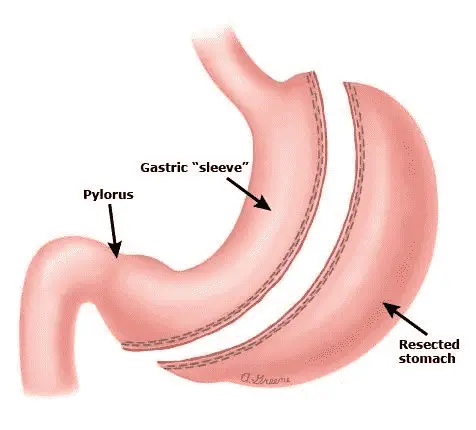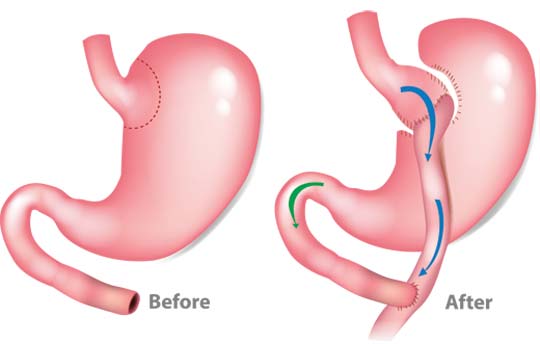Understanding The Alternatives To Gastric Bypass
Understanding The Alternatives To Gastric Bypass. Surgery is always the last resort that you should resort to in the case of obesity. The gastric band as a surgical method is rarely used today because it is less effective than other surgical methods and also involves risks. Learn more about gastric band alternatives here.
Sleeve stomach

In gastric sleeve surgery, the entire stomach is made smaller. All that remains is a tube-like part of the stomach that holds much less volume than before.
As the stomach shrinks, you can only eat small amounts of food.
The disadvantage of the procedure is that there is a risk that the stomach will expand again over time, so that you can again absorb more food and thus more calories.
The risks also include the suture along the gastric band loosening or even tearing open.
Gastric bypass

- When you get gastric bypass, it means that much of the digestive process is bypassed by remodeling the gastrointestinal tract.
- After the food has landed in a small “stomach pocket”, it is immediately directed to the lower part of the small intestine.
- As a result of this restructuring, the organism absorbs far fewer calories, but it is also exposed to the absorption of many nutrients.
- So after gastric bypass you will lose a lot of weight, but you will have to take in important nutrients through dietary supplements.
Note: Gastric bypass is particularly useful if you are affected by type 2 diabetes. The blood sugar levels improve significantly after the operation, so that some patients can even do without their antidiabetic medication after the operation.
Different surgical methods for gastric bypass
Gastric bypass surgery can be performed in different ways. Your doctor will decide which method is suitable for you based on your personal situation.
Omega loop
The “mini bypass” only creates a new connection between the small stomach pouch and the small intestine. The omega-loop bypass is carried out with an extremely enlarged liver or with extremely narrow conditions in the abdominal cavity.
Roux-en-Y gastric bypass
With standard gastric bypass, the small stomach pouch is connected to the small intestine in such a way that the food is digested late. Two new connections are created: between the stomach pouch and the small intestine and between two legs of the small intestine
Gastric balloon
A gastric balloon made of silicone or plastic is usually inserted through the esophagus. The volume that it creates when unfolded in the stomach ensures a feeling of fullness sooner.
You only eat a little until you feel full and lose weight faster. The balloon stays in the body for three to six months.
Doudenal Switch (“small intestine conversion”)
An even larger part of the small intestine is bypassed. The separated small intestine is only reconnected shortly before the large intestine. The procedure is a major procedure and is only used on extremely overweight patients.
Stomach reduction: what types of gastric bypass are there?
If you are obese and want to lose weight, it can take a long time. Following a diet can sometimes be very disappointing, so that you have to deal with chronic obesity. A stomach reduction can offer a solution for those who have been trying to lose weight for years without results. In this type of slimming operation, the stomach is, as it were, made smaller by placing a stomach ring.
As a result, you cannot eat much and you will not get hungry as quickly. People with uncontrollable binge eating sometimes also opt for the option of a stomach reduction. The so-called “stomach ring” is just one of the possibilities of stomach reduction. What types of gastric bypass or gastric bypass are there?
Stomach reduction: for whom?
Obesity
People who are naturally overweight can sometimes benefit from a stomach reduction. Stomach reduction is then seen as a last resort to avoid further health problems caused by obesity. After several attempts to lose weight have failed and the negative effects of obesity on health continue to persist, gastric surgery can be opted for.
Eating disorders
Also in people who remain prey to eating disorders can benefit from gastric reduction surgery because the feeling of hunger will be reduced. As a result, the root cause of the eating disorder, the feeling of hunger, is curbed and the chance of obesity will be a lot smaller in the future.
Types of stomach reduction
If you choose surgery to get rid of obesity forever, you have several options. Four operations are possible in bariatic surgery . Bariatric surgery is the general medical term used to refer to slimming surgery, where baros stands for “weight” and iatros for “physician”. For many people who have struggled with obesity and associated health problems for years, gastric reduction surgery can provide satisfactory results.
Stomach ring
The stomach can be reduced in size in the first place by placing a stomach ring . The stomach ring is placed in the first part of the stomach. This immediately tackles the problem at source: the amount of food you can take in is limited. Through this slimming operation, a weight loss of fifty percent can be achieved after a period of about two years. However, there are quite a few drawbacks to this method, such as the possibility of inflammation and a change in the position of the stomach ring.
Stomach reduction via “gastric bypass”
The gastric bypass is one of the most commonly used surgical procedures to treat obesity. In this slimming operation, the surgeon inserts a smaller stomach just below the esophagus. This is a kind of reservoir that collects food and is directly connected to the small intestine. The result of this gastric bypass is that you can eat less and you feel full in the stomach. Gastric bypass is pretty much the standard of bariatric surgery in general.
“Gastric sleeve”
In the so-called “gastric sleeve” about three quarters of the stomach is removed. The surgeon will make a sleeve or tube from the remaining piece of stomach, so that you will be able to take in less food than before. Special about this operation is also that your hunger feeling is reduced. This is because the operation removes the part of the stomach in which the hunger hormone is produced.
Biliopancreatic Diversion
The least common way to perform weight loss surgery is the biliopancreatic diversion. In this operation, the stomach is partially removed, while the small intestine is also processed. This operation has the disadvantage that nutritional deficiencies can occur. In this case, the patient is often advised to deal with this problem by taking nutritional supplements.
When does the health insurance company cover the costs?
The health insurance company decides on the assumption of the operation costs in individual cases. Make an appointment with your health insurance company before you apply for the costs to be reimbursed.
If you meet the following conditions, there is a chance that the obesity surgery will be accepted:
- BMI of at least 40
- Or: BMI of at least 35 with simultaneous obesity-related comorbidities and overweight for more than three years
- Or: BMI below 35 with serious comorbidities such as difficult-to-control type 2 diabetes
- Age between 18 and 65 years
- At least two unsuccessful diets, cures or rehabs (in the best case under medical guidance)
- Not a serious addiction disease
- Not a serious psychiatric illness
- No existing pregnancy
- Not a serious metabolic disease
What else does the application have to include?
To apply for the reimbursement of surgery for obesity, you must submit all medical reports related to your obesity.
In addition to the reports from your GP, this can also include reports from orthopedists, cardiologists, or endocrinologists.
In addition, you need to show your health insurance company that you are personally willing to contribute to weight loss.
Please enclose a letter of motivation with your application, explaining how you would like to change your diet and lifestyle in general for the better.
These certificates are also helpful:
- Report from a psychologist
- Participation in sports courses
- Participation in nutritional advice
- Food diary
Conclusion
There are many alternatives to the gastric band. Nevertheless, surgery for obesity should always be the last option, and it is only used if conservative treatments have not been successful.
We can only recommend that you consult your doctor in order to find the right treatment method for your body and your individual situation.

